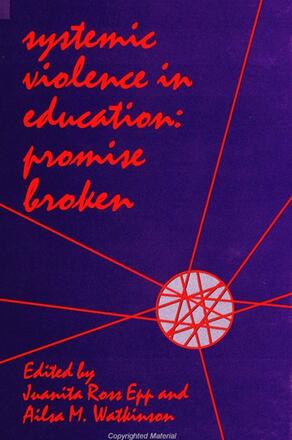Introduction
Part I: Systemic Violence in Administrative Practice
1. Administrative Complicity and Systemic Violence in Education
Ailsa M. Watkinson
While students are given "equal access" to an education, disparaging and discriminatory things sometimes happen on the way to graduation and result in reduced student confidence, lowered academic achievement, and high dropout rates. In this chapter, the issues of school culture, school organization, school leadership, and pedagogy are examined for inherently discriminatory and therefore systemically violent patterns.
2. Authority, Pedagogy, and Violence
Juanita Ross Epp
Authority has traditionally been considered a suitable basis for pedagogy. This gives teachers and administrators tacit permission to use force when it becomes "necessary," that is, when students defy authority and thus compromise their "learning." The applications of authority to pedagogy have strong implications for those who are "other." If we were to seek alternative ways to control children, perhaps women administrators would play a role in changing the way we do schooling.
3. Who Knows? Who Cares? Schools and Coordinated Action on Child Abuse
Rosonna Tite
Teachers and administrators are expected to identify and report incidents of child abuse but this is a complex process which does not always have satisfactory results. Societal bias which accepts male dominance over women and children as the norm, affects the ways in which institutions codify, and sometimes condone forms of child abuse.
Part II: Systemic Violence in Pedagogical Practice
4. Opening Spaces: Examining the Blocks
Pam Whitty
Preschool girls tend to congregate in the art and housekeeping areas and boys engage in more active play with bricks and trucks. How does this happen? An examination of instances in which kindergarten boys appropriate space sheds light on the underlying societal attitudes which allow it to happen.
5. Video Games: Playing on a Violent Playground
Linda Wason-Ellam
The simulated worlds of video games can have an impact on the lives and values of young children. This is an ethnographic study of the literacy learning of an English as a second language learner whose life is enmeshed in rule-governed video games and an examination of the violent themes reenvoiced and intertwined throughout the game player's talk, actions, and writing.
6. Discourses and Silencing in Classroom Space
Mutindi Ndunda
Leaving Kenya to study in Canada awakened this author to issues of race, gender, and class, so she chose women's studies courses and other "progressive" programs where there appeared to be a commitment to equity issues. She was to find, for both herself and for her children, that the "house" was far from being clean.
7. Lethal Labels: Miseducative Discourse about Educative Experiences
Sandra Monteath and Karyn Cooper
Stories of several people's experiences in the educational system are used to illuminate the dangers of the common educational practice of labeling. When labels and categories reduce living, multidimensional human subjects to lifeless, unidimensional objects they become a form of educational violence.
The Other Side of Labeling
Linda Rossler
But labeling is not all bad. This counter argument is added to reflect on the positive aspects of labels.
Part III: Systemic Violence, Women, and Teachers
8. The Family Romance and the Student-Centered Classroom
Lisa Jadwin
Teachers who attempt to use student-centered pedagogy find themselves caught in the traps of patriarchy. In attempting to turn away from the "banking" system of rote memorization, teachers find themselves fighting both bureaucracy and the students' romanticized notions of roles and expectations.
9. Disrupting the Code of Silence: Investigating Elementary Students Sexually Harassing Their Teachers
Elizabeth Richards
Female teachers have learned to live with the sexual harassment they receive from boys. They put up with dirty pictures drawn above their names and whispered sexual slurs. But what would happen if a teacher were to seek institutional support for putting a stop to this insidious violence?
10. Learning from the Learning Place: Case Studies of Harassment in a Post-Secondary Institution
Catharine E. Warren
The systemic nature of harassment is sometimes supported by traditional administrative strategies. The "poisoned environment" impacts on learning and undermines the growth and productivity of people and organizations. What do individuals and groups "learn from the learning place?"
11. Systemic Violence: Linking Women's Stories, Education, and Abuse
Laura Ho, Kathie Webb, and Anne Hughson
When we think about "violence" in our society and in education, we tend to think of violence in purely physical terms. Yet there are far more subtle forms of violence that are just as hurtful, silencing, and damaging. This chapter is an exploration of the kinds of violence three women encountered in their research and in their experiences as teachers and students in educational systems. Their conversations speak to "systemic violence" perpetrated through policies, practices, and structures in educational and social systems.
Part IV: Keeping Promise
12. Personal Reconstruction: When Systemic Violence Stops
Myrna Yuzicapi
This is a personal reflection on how the systemic violence of racism and sexism has affected one person's life and her understanding of what happens when it stops.
13. Addressing Systemic Violence in Education
Ailsa M. Watkinson and Juanita Ross Epp
Systemic violence in schools is associated with administrative and pedagogical practice. The modification of both would require individual as well as systemic change. In this chapter, we examine the reflections of the book's contributors and integrate their understandings of systemic violence while envisioning a world without it.
Contributors
Index
